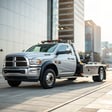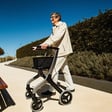The automotive landscape is shifting to bolder expressions of personality. Honda's introduction of Wild Blue represents more than just a color choice—it's a financial statement.
Honda's Wild Blue: A Strategic Investment in Vehicle Differentiation
Honda's new color offering, Wild Blue, is making waves across their vehicle lineup for 2025. This vibrant Honda color isn't just about aesthetics; it represents a calculated move in how consumers view vehicle purchases as expressions of individuality. The bold Honda color joins their palette at a time when vehicle customization has become a significant factor in purchase decisions.
According to industry analysts, unique vehicle colors can impact resale values by 3-5% compared to standard options like white, black, and silver. This makes the wild blue Honda option potentially more than just a style choice—it's a financial consideration for forward-thinking buyers.
The Honda Civic Type R, already available in Boost Blue Pearl (with a $455 premium color charge), demonstrates how specialty colors command price premiums. The new Honda edition featuring Wild Blue is expected to follow a similar pricing strategy across multiple models.
Financial Implications of Unique Honda Paint Options
When considering a wild blue car purchase, consumers should evaluate several financial factors:
- Initial premium costs for specialty colors
- Potential resale value impacts
- Insurance considerations for premium finishes
- Maintenance costs for specialized paint
The Honda color 2025 lineup represents a shift in how manufacturers view vehicle customization. While traditional wisdom suggested neutral colors for maximum resale value, the market has evolved. Unique finishes like Wild Blue can now command attention from specific buyer segments willing to pay premiums for standout vehicles.
"Vehicle color selection has transformed from a purely aesthetic choice to a financial consideration," notes automotive valuation expert James Harton. "Distinctive colors like Honda's Wild Blue can actually preserve value in certain market segments where individuality commands a premium."
Honda Style 2025: Market Positioning Through Color Psychology
The vibrant Honda color strategy aligns with broader market trends showing consumers increasingly viewing vehicles as extensions of personal identity. This has direct financial implications for both manufacturers and consumers.
For Honda, the introduction of Wild Blue represents:
- Brand differentiation in a crowded marketplace
- Potential for increased margins on specialty finishes
- Appeal to younger demographics seeking personalization
- Competition with luxury brands through distinctive styling
From a consumer finance perspective, investing in a vehicle with unique Honda paint like Wild Blue means considering both short-term costs and long-term value retention. While the upfront premium might range from $400-800 depending on model, the differentiation could pay dividends at trade-in time.
What Makes Wild Blue Honda Different from Standard Color Options?
Unlike conventional blue automotive paints, the wild blue car option features depth-enhancing pigments and specialized finish techniques that create a more dynamic appearance under varying light conditions. This technical distinction explains part of the premium pricing structure.
The manufacturing process for specialty colors typically involves:
- Additional quality control steps
- Higher-grade pigments and clear coats
- More complex application procedures
- Limited production runs
These factors contribute to both the initial cost premium and potential future value retention of vehicles featuring the bold Honda color option.
Financial Planning for Your Honda New Color Purchase
When budgeting for a vehicle featuring Honda's Wild Blue, consider these financial planning steps:
- Calculate the total premium cost (color charge plus any required trim level upgrades)
- Research insurance implications for specialty finishes
- Consider geographic factors (sun exposure in your region may affect maintenance)
- Evaluate resale timing strategy (3-5 years typically maximizes specialty color value)
The unique Honda paint option represents approximately 1-2% of the vehicle's total purchase price, making it a relatively minor financial consideration in the overall transaction. However, proper maintenance of specialty finishes becomes important for preserving this investment.
Is Wild Blue Honda Worth the Premium in the Long Run?
When evaluating whether to invest in the vibrant Honda color option, consider your personal financial timeline and vehicle ownership patterns.
For long-term owners (7+ years), the initial premium amortizes to minimal annual cost while providing ongoing enjoyment. For shorter-term owners (2-4 years), the potential resale advantage becomes more significant in the financial equation.
Data from automotive resale platforms suggests that distinctive colors like Wild Blue can command 2-7% higher resale values in certain market segments, particularly for sporty models like the Civic Type R or lifestyle vehicles like the redesigned HR-V.
"The 2026 HR-V compact SUV in Wild Blue creates a compelling value proposition for buyers seeking distinctiveness without moving to luxury brands," notes consumer automotive finance specialist Tara Reynolds. "This positioning helps Honda capture buyers who might otherwise stretch their budgets for premium brands."
Conclusion: Making a Financially Sound Color Choice
The Honda Wild Blue option represents the intersection of personal preference and financial consideration. While traditional finance advice might suggest avoiding specialty colors, evolving market dynamics have changed this calculation for certain vehicle segments.
For those considering this bold Honda color option, balancing the initial premium against potential resale advantages and personal enjoyment creates a more nuanced financial decision than simply minimizing upfront costs.
Disclaimer: This content is for informational purposes only and does not constitute financial advice. Vehicle color preferences, market conditions, and resale values vary by region and model. Consult with a financial advisor for personalized guidance on major purchases.
Tags

About Elena Schwarzkopf the Author
Elena Schwarzkopf is a seasoned finance writer with over a decade of experience in crafting actionable budgeting tips that help individuals regain control over their finances. Known for her practical approach, Elena's insights empower readers to transform their financial habits and achieve their savings goals.
Recommended Articles
How to Detect Macular Degeneration Early
Learn to detect macular degeneration early through eye exams and understanding symptoms, ensuring proactive eye health management.
Rent-to-Own Tow Trucks: What to Know in 2026
Explore rent-to-own tow trucks in 2026, offering flexibility for operators to gradually gain ownership while managing costs effectively.
How to Spot a Valuable Toy Before Selling It at a Garage Sale
Learn how to identify valuable toys to sell at garage sales, maximizing profit while decluttering your home. Find out what buyers are looking for!
5 Old Household Items That Are Suddenly Worth Money
Discover five old household items that could be worth a lot of money today, from vintage typewriters to collectible toys and more.
The Smart Rollator That’s Redefining Independence for Seniors
Smart rollators are revolutionizing senior mobility by integrating advanced technology, such as intelligent braking systems, GPS for location tracking, and health monitoring features, which improve safety and reduce healthcare costs through fall prevention. These devices, despite their higher upfront cost, offer long-term financial benefits by delaying the need for costly home care, and some insurance plans may cover the associated expenses.





